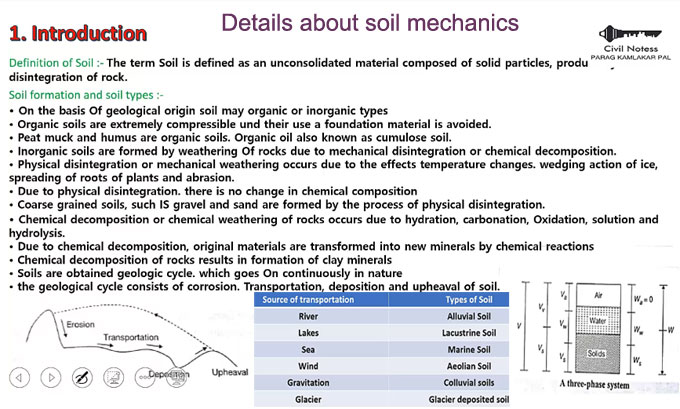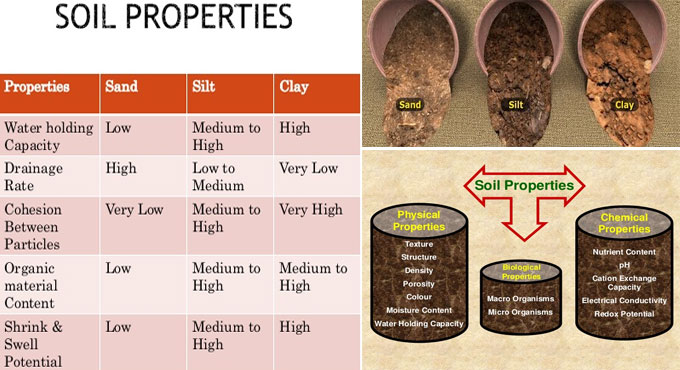This civil engineering article is based on soil mechanics. The article focuses on soil development, source of transportation of soil, normally found soil designation, soil structure etc.
How soil is developed?
1. The soil is categorized as organic or inorganic depending on the geological source.
2. As organic soils very compressible, they should not be used as a foundation material.
3. Organic soils are also known as cumulose soil. Examples of organic soils are peat muck and humus.
4. To develop inorganic soils, the rocks are seasoned because of mechanical decay or chemical degradation.
5. Physical decomposition or mechanical weathering happens because of the impact of temperature variations.
6. Because of physical decomposition, chemical composition of soil remains unchanged.
7. Course grained soils like IS gravel and sand are built up with the method of physical decomposition.
8. Chemical disintegration or chemical weathering of rocks happens owing to hydration, carbonation, oxidation, solution and hydrolysis.
9. Because of chemical disintegration, original materials are changed to new materials through chemical reactions.
10. Chemical degradation of rocks leads to development of clay minerals.
11. Soils are made with geologic cycle that runs uninterruptedly in nature.
The geological cycle contains corrosion, transportation, deposition and upheaval of soil.
Normally applied soil designation:
Bentonite : Disintegrated volcanic ash in which high percentage of clay mineral (montmorillonite) are included.
Black Cotton Soil : It contains the mineral montmorillonite and discharge large swelling and shrinkage.
Loam : It is formed by mixing sand, silt and clay size particles approximately in same ratios.
Moorum : It belongs to gravel blended with red clay.
Varved clay : It belongs to clay and silt of glacial origin particularly a lacustrine deposited.
Go through the following video for online demonstration www.youtube.com

~~~~~~~~~~~~~~~~~~~~~~~~
Published By
Rajib Dey
www.constructioncost.co
~~~~~~~~~~~~~~~~~~~~~~~~
How soil is developed?
1. The soil is categorized as organic or inorganic depending on the geological source.
2. As organic soils very compressible, they should not be used as a foundation material.
3. Organic soils are also known as cumulose soil. Examples of organic soils are peat muck and humus.
4. To develop inorganic soils, the rocks are seasoned because of mechanical decay or chemical degradation.
5. Physical decomposition or mechanical weathering happens because of the impact of temperature variations.
6. Because of physical decomposition, chemical composition of soil remains unchanged.
7. Course grained soils like IS gravel and sand are built up with the method of physical decomposition.
8. Chemical disintegration or chemical weathering of rocks happens owing to hydration, carbonation, oxidation, solution and hydrolysis.
9. Because of chemical disintegration, original materials are changed to new materials through chemical reactions.
10. Chemical degradation of rocks leads to development of clay minerals.
11. Soils are made with geologic cycle that runs uninterruptedly in nature.
Normally applied soil designation:
Bentonite : Disintegrated volcanic ash in which high percentage of clay mineral (montmorillonite) are included.
Black Cotton Soil : It contains the mineral montmorillonite and discharge large swelling and shrinkage.
Loam : It is formed by mixing sand, silt and clay size particles approximately in same ratios.
Moorum : It belongs to gravel blended with red clay.
Varved clay : It belongs to clay and silt of glacial origin particularly a lacustrine deposited.
Go through the following video for online demonstration www.youtube.com

~~~~~~~~~~~~~~~~~~~~~~~~
Published By
Rajib Dey
www.constructioncost.co
~~~~~~~~~~~~~~~~~~~~~~~~
